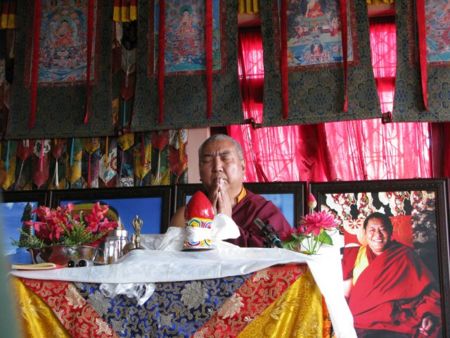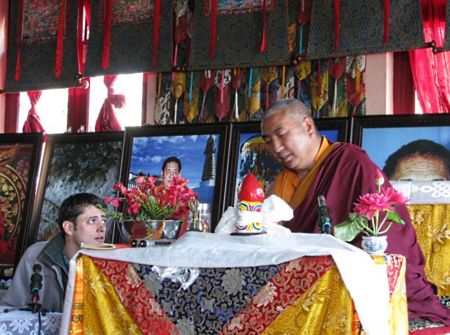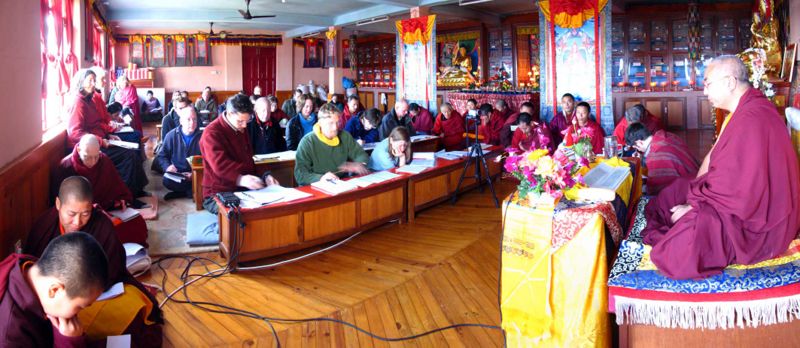Khenpo Namdrol 2008 Teachings on Buddha Nature: Difference between revisions
mNo edit summary |
No edit summary |
||
| (23 intermediate revisions by 3 users not shown) | |||
| Line 1: | Line 1: | ||
[[Image:KhenpoNamdrolTeaching.jpg|thumb|450px|[[Khenpo Namdrol|Khenchen Namdrol]] teaching at the [[Rigpa Shedra]] East 2008 / 2009 in [[Pharping]]]] | [[Image:KhenpoNamdrolTeaching.jpg|thumb|450px|[[Khenpo Namdrol|Khenchen Namdrol]] teaching at the [[Rigpa Shedra]] East 2008 / 2009 in [[Pharping]]]] | ||
[[Khenpo Namdrol|Khenchen Namdrol Rinpoche]] | [[Khenpo Namdrol|Khenchen Namdrol Rinpoche]] taught the [[Rigpa Shedra]] on [[Mipham Rinpoche]]'s work on [[buddha nature]] (Skt. ''sugatagarbha''): ''[[The Lion's Roar: A Commentary on Sugatagarbha]]''. | ||
[[Image:Rss2.jpg|left|Podcast]] Follow the teachings as '''podcast''' at: [http://www.rigpawiki.org/Media/Audio/2008-2009/podcast.rss http://www.rigpawiki.org/Media/Audio/2008-2009/podcast.rss] To automatically download all buddha-nature teachings with iTunes, select within iTunes: ''Advanced/Subscribe to podcast...'' and paste the podcast-link above. Be sure to select to download all episodes in ''Settings''. | [[Image:Rss2.jpg|left|Podcast]] Follow the teachings as '''podcast''' at: [http://www.rigpawiki.org/Media/Audio/2008-2009/podcast.rss http://www.rigpawiki.org/Media/Audio/2008-2009/podcast.rss] To automatically download all buddha-nature teachings with iTunes, select within iTunes: ''Advanced/Subscribe to podcast...'' and paste the podcast-link above. Be sure to select to download all episodes in ''Settings''. | ||
| Line 12: | Line 10: | ||
==Study Material== | ==Study Material== | ||
Douglas Duckworth has recently published an English translation of the text we are studying:<br> | [http://www.uncg.edu/rel/contacts/faculty/Duckworth.htm Douglas Duckworth] has recently published an English translation of the text we are studying:<br> | ||
*Douglas Duckworth, ''Mipam on Buddha-Nature. The Ground of the Nyingma Tradition'', State University of New York Press, 2008. ISBN 978-0-7914-7521-8. The translation is contained in Appendix 1. | *Douglas Duckworth, ''Mipam on Buddha-Nature. The Ground of the Nyingma Tradition'', State University of New York Press, 2008. ISBN 978-0-7914-7521-8. The translation is contained in Appendix 1. | ||
| Line 32: | Line 30: | ||
===1. Proof of the Presence of the Tathagatagarbha in all [[sentient beings|Sentient Beings]]=== | ===1. Proof of the Presence of the Tathagatagarbha in all [[sentient beings|Sentient Beings]]=== | ||
The [[Uttaratantra Shastra]] says: | The [[Uttaratantra Shastra]] says: | ||
:''Because the perfect buddhas’s [[kaya]] is all-pervading,<br>Because reality is undifferentiated,<br>And because they possess the potential,''<ref>The alternative translation for potential (Tib. ''rig''; Wyl. ''rigs'') used during the teachings is ''nature'' or the Sanskrit ''gotra'' (here ''go'' comes from ''guna'', quality. ''Tra'' means to protect. So gotra means to protect the qualities (Wyl. ''yon ten skyob pa'') [RY])</ref><br>''Beings always have the buddha nature.''<ref>''Sublime Continuum'', I, 27. Translation Adam Pearcey, ''[http://lotsawaschool.org/maitreya_quotes.html Compendium of Quotations VI]'', p. 49</ref> | :'''27.''' ''Because the perfect buddhas’s [[kaya]] is all-pervading,<br>Because reality is undifferentiated,<br>And because they possess the potential,''<ref>The alternative translation for potential (Tib. ''rig''; Wyl. ''rigs'') used during the teachings is ''nature'' or the Sanskrit ''gotra'' (here ''go'' comes from ''guna'', quality. ''Tra'' means to protect. So gotra means to protect the qualities (Wyl. ''yon ten skyob pa'') [RY])</ref><br>''Beings always have the buddha nature.''<ref>''Sublime Continuum'', I, 27. Translation Adam Pearcey, ''[http://lotsawaschool.org/maitreya_quotes.html Compendium of Quotations VI]'', p. 49</ref> | ||
====1.1 The Mistaken Apprehension of Others==== | ====1.1 The Mistaken Apprehension of Others==== | ||
| Line 55: | Line 53: | ||
* ''7<sup>th</sup> teaching, 23-Dec-2008:'' The nature as the great uncompounded which is unchanging and never separated from it's qualities. <br>'''online:''' [http://www.rigpawiki.org/Media/Audio/2008-2009/20081223PH0930KN.mp3 20081223PH0930KN.mp3]<br>See Tibetan: Mipham ''gsung 'bum'', Vol 4., p. 575-577. English: Duckworth, p.156-158 | * ''7<sup>th</sup> teaching, 23-Dec-2008:'' The nature as the great uncompounded which is unchanging and never separated from it's qualities. <br>'''online:''' [http://www.rigpawiki.org/Media/Audio/2008-2009/20081223PH0930KN.mp3 20081223PH0930KN.mp3]<br>See Tibetan: Mipham ''gsung 'bum'', Vol 4., p. 575-577. English: Duckworth, p.156-158 | ||
=====1.2.2 The Second Line: | =====1.2.2 The Second Line: ''Because Suchness is Indivisible''===== | ||
* ''8<sup>th</sup> teaching, 24-Dec-2008:'' An answer to objections concerning the presence of the essence of enlightenment in all sentient beings. Why the all-pervasiveness of gotra (''rigs'') is not refuted by stating that stones have no nature?<br>'''online:''' [http://www.rigpawiki.org/Media/Audio/2008-2009/20081224PH0930KN.mp3 20081224PH0930KN.mp3]<br>See Tibetan: Mipham ''gsung 'bum'', Vol 4., p. 577-580. English: Duckworth, p.158-160 | |||
* ''9<sup>th</sup> teaching, 25-Dec-2008:'' Individual deluded perception does not contradict the authentic viewpoint that all perceptions appear without ever moving from the primordially enlightened state of dharmata. Anwers to objections. <br>'''online:''' [http://www.rigpawiki.org/Media/Audio/2008-2009/20081225PH0930KN.mp3 20081225PH0930KN.mp3]<br>See Tibetan: Mipham ''gsung 'bum'', Vol 4., p. 580-583. English: Duckworth, p.160-162 | |||
=====1.2.3 The Third Line: ''Because They have the Nature''===== | |||
* ''10<sup>th</sup> teaching, 26-Dec-2008:'' Each of the three lines relates to one of the first three [[Four principles of reasoning|principles of reasoning]] thus establishing that all beings have buddha-nature.<br>'''online:''' [http://www.rigpawiki.org/Media/Audio/2008-2009/20081226PH0930KN.mp3 20081226PH0930KN.mp3]<br>See Tibetan: Mipham ''gsung 'bum'', Vol 4., p. 583-585. English: Duckworth, p.162-164 | |||
* ''11<sup>th</sup> teaching, 27-Dec-2008:'' The teachings on sugatagarbha focus on the inseparability of the appearance of kayas and wisdom with their emtpy nature. Both, the teachings of the intermediate turning, which focus more on the emptiness aspect, and the teachings of the final turning, which focus more on the spontaneous presence aspect are therefore definitive teachings and need to be seen in union.<br>'''online:''' [http://www.rigpawiki.org/Media/Audio/2008-2009/20081227PH1330KN.mp3 20081227PH1330KN.mp3]<br>See Tibetan: Mipham ''gsung 'bum'', Vol 4., p. 585-587. English: Duckworth, p.164-165 | |||
[[Image:Classroom-with-Khenpo-Namdrol-teaching-1.jpg|800px|thumb|An assembly of monks and nuns, local Sangha and the Rigpa Shedra following Khen Rinpoche Namdrol's teachings]] | |||
===2. Refuting Some Misconceptions Concerning the Nature of the Element=== | |||
* ''12<sup>th</sup> teaching, 28-Dec-2008:'' How the element (''khams'') abides within the continua of sentient beings. The refutation of some misconceptions concerning the nature of the element.<br>'''online:''' [http://www.rigpawiki.org/Media/Audio/2008-2009/20081228PH0930KN.mp3 20081228PH0930KN.mp3]<br>See Tibetan: Mipham ''gsung 'bum'', Vol 4., p. 587-590. English: Duckworth, p.165-168 | |||
====2.1 Refuting the view that the element is truly existent and not empty==== | |||
* '' | ====2.2 Refuting the view that the element is an empty void==== | ||
====2.3 Refuting the view that the element is impermanent and compounded==== | |||
* ''13<sup>th</sup> teaching, 30-Dec-2008:'' A refutation of misconceptions by scripture and by reasoning: the element is neither truly existent, nor an empty void, nor is it impermanent and compounded.<br>'''online:''' [http://www.rigpawiki.org/Media/Audio/2008-2009/20081230PH0930KN.mp3 20081230PH0930KN.mp3]<br>See Tibetan: Mipham ''gsung 'bum'', Vol 4., p. 590-594. English: Duckworth, p.168-171 | |||
* ''14<sup>th</sup> teaching, 31-Dec-2008:'' For those who have not transformed themselves and have dualistic perceptions, there is the incontrovertible and undeniable appearance of inequality. Yet the fundamental nature abides as the great equality in which arising, ceasing, and dualistic phenomena do not exist.<br>'''online:''' [http://www.rigpawiki.org/Media/Audio/2008-2009/20081231PH0930KN.mp3 20081231PH0930KN.mp3]<br>See Tibetan: Mipham ''gsung 'bum'', Vol 4., p. 594-598. English: Duckworth, p.171-174 | |||
* ''15<sup>th</sup> teaching, 01-Jan-2009:'' The benefits and the purpose of studying buddha-nature. The dedication. This concludes Khen Rinpoche Namdrol's teachings on the ''sengge naro'', the ''Lion's Roar'' by [[Mipham Rinpoche]]. <br>'''online:''' [http://www.rigpawiki.org/Media/Audio/2008-2009/20090101PH0930KN.mp3 20090101PH0930KN.mp3]<br>See Tibetan: Mipham ''gsung 'bum'', Vol 4., p. 598-606. English: Duckworth, p.174-180 | |||
<br> | |||
:::::::''Virtue!'' | |||
<br> | |||
''The Rigpa Shedra continues with: [[Shedra 2009 Teachings on Mipham Rinpoche's commentary on the Uttaratantra Shastra]]. Visit the [[Shedra MP3 Library]] for more online-teachings.'' | |||
==References== | ==References== | ||
<small><references/></small> | <small><references/></small> | ||
[[Category: Buddha Nature]] | [[Category: Buddha Nature]] | ||
[[Category: MP3 Library]] | [[Category: MP3 Library]] | ||
[[Category: Rigpa Shedra]] | |||
[[Category: Shedra East 2008]] | |||
Latest revision as of 17:08, 13 July 2010

Khenchen Namdrol Rinpoche taught the Rigpa Shedra on Mipham Rinpoche's work on buddha nature (Skt. sugatagarbha): The Lion's Roar: A Commentary on Sugatagarbha.

Follow the teachings as podcast at: http://www.rigpawiki.org/Media/Audio/2008-2009/podcast.rss To automatically download all buddha-nature teachings with iTunes, select within iTunes: Advanced/Subscribe to podcast... and paste the podcast-link above. Be sure to select to download all episodes in Settings.
Recorded during Shedra East 2008-2009 in Pharping, Nepal

Study Material
Douglas Duckworth has recently published an English translation of the text we are studying:
- Douglas Duckworth, Mipam on Buddha-Nature. The Ground of the Nyingma Tradition, State University of New York Press, 2008. ISBN 978-0-7914-7521-8. The translation is contained in Appendix 1.
The Tibetan is contained in Mipham Rinpoche's collected works (gsung 'bum), Volume pod 4 pa
- bde gshegs snying po'i stong thun chen mo seng ge'i nga ro p. 563-608. See TBRC
The Lion's Roar: A Commentary on Sugatagarbha
By Jamgön Mipham Rinpoche
Prologue
- 1st teaching, 16-Dec-2008: How is buddha nature taught in sutra, tantra and Dzogchen?
online: 20081216PH0930KN.mp3
Introduction
- 2nd teaching, 17-Dec-2008: Our teacher the Buddha has taught on buddha nature emphazising sugatagarbha's essence (Wyl. ngo bo) by teaching on emptiness. On other occasions, he gave clarifications on its nature (Wyl. rang bzhin) by explaining its primordially present qualities. It is crucial to understand that those two aspects are in union.
online: 20081217PH0930KN.mp3
See Tibetan: Mipham gsung 'bum, Vol 4., p. 564-565. English: Duckworth, p.147-148
- 3rd teaching, 18-Dec-2008: Accuracy of scriptures can be examined by the three types of investigation and understanding establishes irreversible trust by means of the three types of valid cognition.[1] How can buddha nature (tathagatagarbha) be established in this way, as being empty in essence while cognizant in nature?
online: 20081218PH0930KN.mp3
See Tibetan: Mipham gsung 'bum, Vol 4., p. 566-567. English: Duckworth, p.148-149
1. Proof of the Presence of the Tathagatagarbha in all Sentient Beings
The Uttaratantra Shastra says:
- 27. Because the perfect buddhas’s kaya is all-pervading,
Because reality is undifferentiated,
And because they possess the potential,[2]
Beings always have the buddha nature.[3]
1.1 The Mistaken Apprehension of Others
- 4th teaching, 19-Dec-2008: A refutation of the position of early Tibetan commentators concerning the interpretation of the meaning of the Uttaratantra Shastra verse. Neither is the fact that the dharmakaya pervades everything sufficient for the existent of the nature (Tib. rigs) nor can suchness be simply understood as mere emptiness in the sense of the approximate ultimate.
online: 20081219PH0930KN.mp3
See Tibetan: Mipham gsung 'bum, Vol 4., p. 567-569. English: Duckworth, p.149-151
Nature (rigs) as the union of the two truths
- 5th teaching, 20-Dec-2008: The sugatagarbha is the indivisible union, beyond any possibility of being united or separated, of the primordial purity of the cause and effect of samsara, and untainted appearances which are natural and spontaneous clear light.
online: 20081220PH0930KN.mp3
See Tibetan: Mipham gsung 'bum, Vol 4., p. 569-572. English: Duckworth, p.151-153
1.2 Our Tradition
1.2.1 The Meaning of the First Line: Because the perfect buddhas’s kaya is all-pervading
1.2.1.1 General Reasoning
1.2.1.2 Specific Points
- 6th teaching, 22-Dec-2008: How to establish by reasoning that the sugatagarbha is already present in all beings?
online: 20081222PH0930KN.mp3
See Tibetan: Mipham gsung 'bum, Vol 4., p. 572-575. English: Duckworth, p.153-156
From the Uttaratantra Shastra:
- The disposition[4] is empty of the adventitious stains,
Which are characterized by their total separateness.
But it is not empty of the unsurpassed qualities,
Which have the character of total inseparability.[5]
- 7th teaching, 23-Dec-2008: The nature as the great uncompounded which is unchanging and never separated from it's qualities.
online: 20081223PH0930KN.mp3
See Tibetan: Mipham gsung 'bum, Vol 4., p. 575-577. English: Duckworth, p.156-158
1.2.2 The Second Line: Because Suchness is Indivisible
- 8th teaching, 24-Dec-2008: An answer to objections concerning the presence of the essence of enlightenment in all sentient beings. Why the all-pervasiveness of gotra (rigs) is not refuted by stating that stones have no nature?
online: 20081224PH0930KN.mp3
See Tibetan: Mipham gsung 'bum, Vol 4., p. 577-580. English: Duckworth, p.158-160
- 9th teaching, 25-Dec-2008: Individual deluded perception does not contradict the authentic viewpoint that all perceptions appear without ever moving from the primordially enlightened state of dharmata. Anwers to objections.
online: 20081225PH0930KN.mp3
See Tibetan: Mipham gsung 'bum, Vol 4., p. 580-583. English: Duckworth, p.160-162
1.2.3 The Third Line: Because They have the Nature
- 10th teaching, 26-Dec-2008: Each of the three lines relates to one of the first three principles of reasoning thus establishing that all beings have buddha-nature.
online: 20081226PH0930KN.mp3
See Tibetan: Mipham gsung 'bum, Vol 4., p. 583-585. English: Duckworth, p.162-164
- 11th teaching, 27-Dec-2008: The teachings on sugatagarbha focus on the inseparability of the appearance of kayas and wisdom with their emtpy nature. Both, the teachings of the intermediate turning, which focus more on the emptiness aspect, and the teachings of the final turning, which focus more on the spontaneous presence aspect are therefore definitive teachings and need to be seen in union.
online: 20081227PH1330KN.mp3
See Tibetan: Mipham gsung 'bum, Vol 4., p. 585-587. English: Duckworth, p.164-165

2. Refuting Some Misconceptions Concerning the Nature of the Element
- 12th teaching, 28-Dec-2008: How the element (khams) abides within the continua of sentient beings. The refutation of some misconceptions concerning the nature of the element.
online: 20081228PH0930KN.mp3
See Tibetan: Mipham gsung 'bum, Vol 4., p. 587-590. English: Duckworth, p.165-168
2.1 Refuting the view that the element is truly existent and not empty
2.2 Refuting the view that the element is an empty void
2.3 Refuting the view that the element is impermanent and compounded
- 13th teaching, 30-Dec-2008: A refutation of misconceptions by scripture and by reasoning: the element is neither truly existent, nor an empty void, nor is it impermanent and compounded.
online: 20081230PH0930KN.mp3
See Tibetan: Mipham gsung 'bum, Vol 4., p. 590-594. English: Duckworth, p.168-171
- 14th teaching, 31-Dec-2008: For those who have not transformed themselves and have dualistic perceptions, there is the incontrovertible and undeniable appearance of inequality. Yet the fundamental nature abides as the great equality in which arising, ceasing, and dualistic phenomena do not exist.
online: 20081231PH0930KN.mp3
See Tibetan: Mipham gsung 'bum, Vol 4., p. 594-598. English: Duckworth, p.171-174
- 15th teaching, 01-Jan-2009: The benefits and the purpose of studying buddha-nature. The dedication. This concludes Khen Rinpoche Namdrol's teachings on the sengge naro, the Lion's Roar by Mipham Rinpoche.
online: 20090101PH0930KN.mp3
See Tibetan: Mipham gsung 'bum, Vol 4., p. 598-606. English: Duckworth, p.174-180
- Virtue!
The Rigpa Shedra continues with: Shedra 2009 Teachings on Mipham Rinpoche's commentary on the Uttaratantra Shastra. Visit the Shedra MP3 Library for more online-teachings.
References
- ↑ (Wyl. tshad ma gsum) Another expression for the three types of investigation
- ↑ The alternative translation for potential (Tib. rig; Wyl. rigs) used during the teachings is nature or the Sanskrit gotra (here go comes from guna, quality. Tra means to protect. So gotra means to protect the qualities (Wyl. yon ten skyob pa) [RY])
- ↑ Sublime Continuum, I, 27. Translation Adam Pearcey, Compendium of Quotations VI, p. 49
- ↑ (Wyl. khams), translated as element during the teachings.
- ↑ Sublime Continuum, I, 155. Translation Adam Pearcey, Compendium of Quotations VI